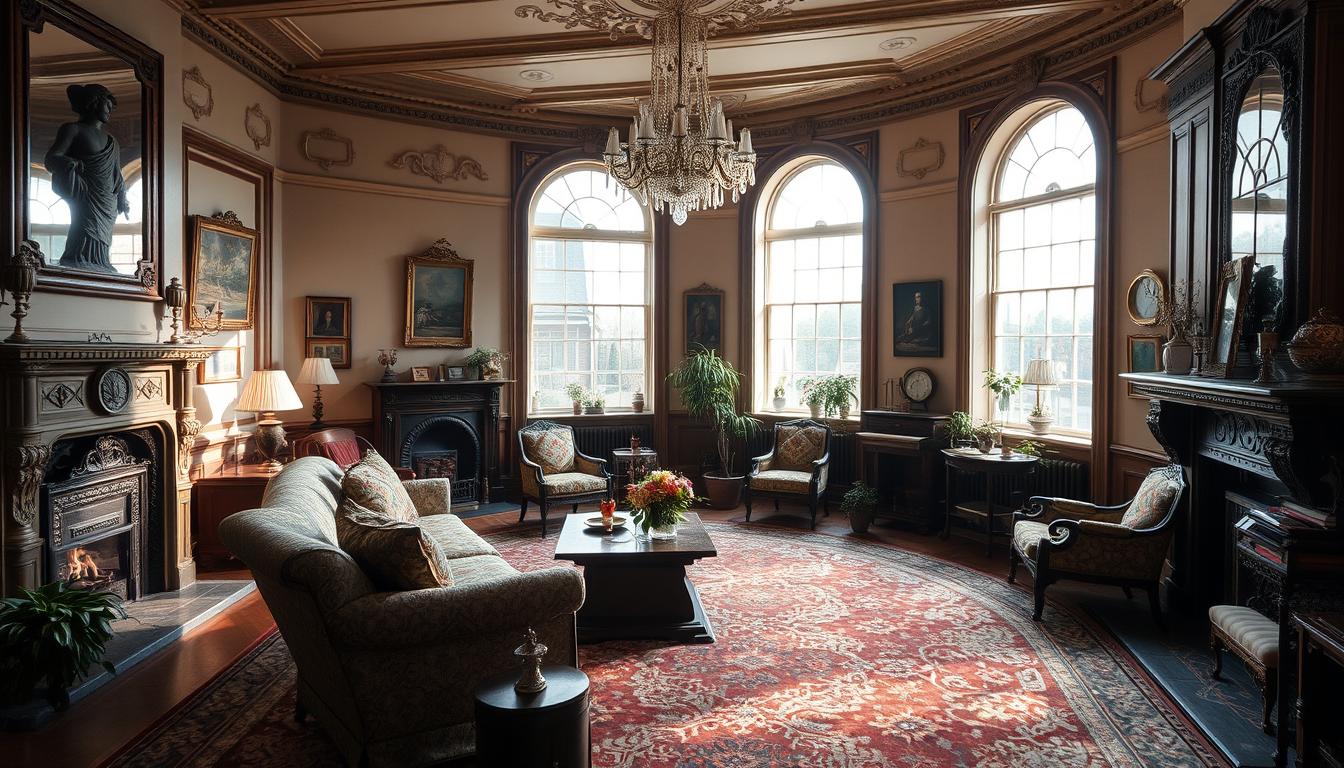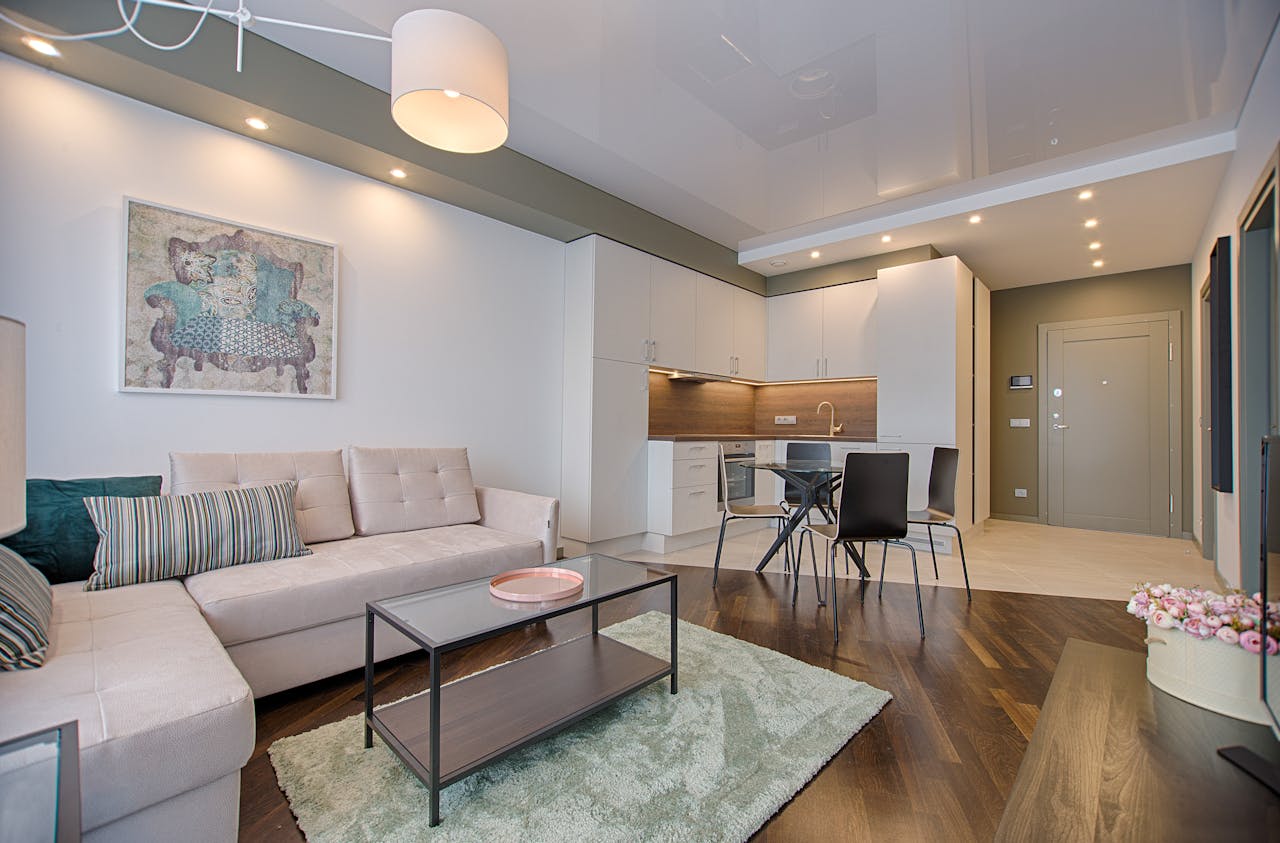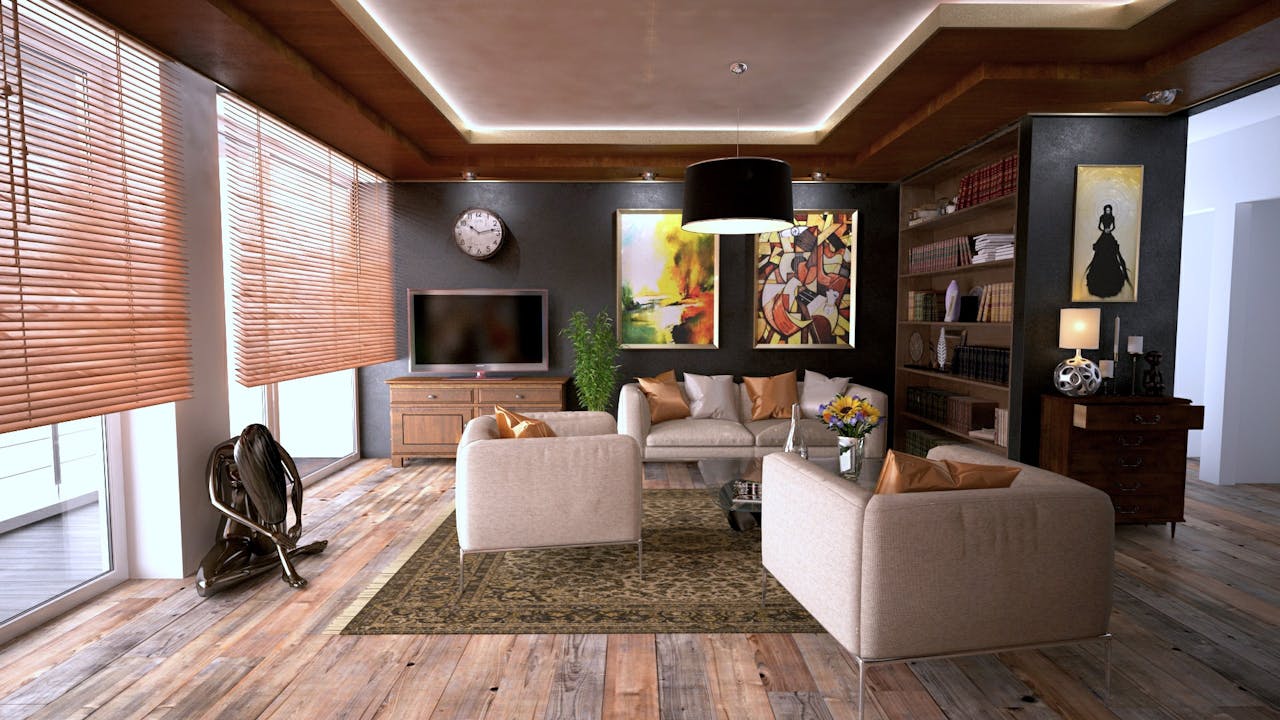The beauty of Edwardian home decor still charms many today. It mixes elegance with comfort in a way that’s irresistible. This style, from the early 20th century, has proven to be timeless. It’s a favorite for those wanting a cozy and welcoming home.
Let’s dive into the Edwardian homes interior world. We’ll look at what makes this style last, like its classic colors and fancy furniture. We’ll also share tips on how to bring this charm into your home. This way, you can create a space that feels both old and new.
Key Takeaways
- Understanding the core elements of Edwardian home decor
- Tips for incorporating Edwardian style into your home
- The importance of color palettes in creating a timeless look
- How to balance elegance with comfort in your interior design
- Popular furniture pieces that define the Edwardian era
Understanding Edwardian Architecture and Design
The Edwardian era, from 1901 to 1910, saw a big change in home design. It moved away from the heavy styles of the past. Instead, it adopted a lighter, more modern look.
Key Features of Edwardian Homes
Edwardian homes stand out for several reasons. They are known for:
- Simplicity and Elegance: They moved away from the Victorian era’s heavy ornamentation. They opted for cleaner lines and simpler decor.
- Light and Airy Interiors: They used larger windows and lighter colors. This created a bright and open feel.
- Mix of Traditional and Modern Elements: They combined classic and contemporary designs. This created a unique look.
The Evolution of Interior Design in the Edwardian Era
The Edwardian era brought big changes to interior design. These changes were driven by new technologies and shifting values. Some key developments were:
- New materials and technologies allowed for more varied and sophisticated designs.
- There was a focus on comfort and functionality. This reflected the changing lifestyles and needs of households.
- The influence of art movements like Arts and Crafts was seen. They promoted handcrafted elements and traditional craftsmanship.
In conclusion, the Edwardian era was a turning point in home decor history. It marked a shift towards simplicity, light, and a mix of old and new. Understanding these principles helps create beautiful and functional spaces today.
Common Edwardian Interior Styles
The Edwardian era introduced a variety of interior styles that still shape home decor today. These styles mixed traditional and modern elements. They were influenced by different design movements, creating a unique look.
Edwardian interiors were known for their eclecticism. Designers and homeowners drew from many sources. They chose elements that showed their personal taste and the styles of the time.
Arts and Crafts Influence
The Arts and Crafts movement greatly influenced Edwardian interiors. It valued handcrafted goods and the skill of artisans. This movement made people appreciate the craftsmanship in furniture and decorations.
“The Arts and Crafts movement was a reaction against the industrialization of design, seeking to revive the importance of human craftsmanship in the creation of beautiful objects.”
This influence is seen in the use of natural materials and focus on function. Decorative elements also showed the artisan’s skill.
Neoclassical Touches
Neoclassicism, inspired by ancient Greek and Roman design, also shaped Edwardian interiors. It brought elegance and sophistication with its use of classical motifs and symmetry.
Neoclassical touches include columns, pediments, and moldings. These were used in furniture, architecture, and accessories.
Vibrant Colors and Patterns
Edwardian interiors were known for their bold colors and patterns. Rich textiles, vibrant wallpapers, and colorful ceramics made spaces lively and inviting.
| Color/Pattern | Common Uses | Characteristics |
|---|---|---|
| Rich Reds and Blues | Upholstery, wallpapers | Deep, saturated hues |
| Floral Patterns | Textiles, wallpapers | Intricate, naturalistic designs |
| Geometric Patterns | Tile work, flooring | Repeating geometric motifs |
Using these vibrant colors and patterns added depth and interest. Homeowners could make their spaces unique and personalized.
Furniture Choices for Edwardian Interiors
To create a true Edwardian interior, picking the right furniture is crucial. Edwardian pieces are known for their clean lines, simple designs, and high-quality materials.
Popular Materials and Finishes
In the Edwardian era, certain materials and finishes were favored. Oak, mahogany, and walnut were top choices, polished to highlight their beauty.
Upholstered furniture became more common. Velvet, silk, and linen were used for chairs, sofas, and more.
| Material | Common Use | Notable Feature |
|---|---|---|
| Oak | Dining tables, chairs | Durability, grain pattern |
| Mahogany | Sofas, armchairs | Rich color, fine grain |
| Walnut | Cabinets, sideboards | Dark, luxurious finish |
Iconic Edwardian Furniture Pieces
Some furniture is truly Edwardian, like the Chippendale-style chair and the Edwardian sofa with its rolled arms.
These pieces show off the era’s style while also being comfortable and useful.
Tips for Sourcing Authentic Furniture
For an authentic Edwardian look, finding original or high-quality reproductions is essential.
- Visit antique shops and auctions for original pieces.
- Think about getting a custom piece from a skilled craftsman.
- Look for reproductions that match the era’s materials and craftsmanship.
By focusing on these tips, you can create an interior that truly feels like the Edwardian era.
Color Palettes That Define Edwardian Homes
Edwardian homes are known for their rich, muted colors. These colors add warmth and sophistication. The Edwardian period, from the late 19th to the early 20th century, celebrated classical influences and craftsmanship. This is seen in their interior design.
Warm Neutrals and Earth Tones
Edwardian interiors often feature warm neutrals and earth tones. Beige, taupe, and soft browns were favorites. They made spaces cozy and inviting.
These earthy tones were paired with rich wood furniture and detailed carpets and rugs. This combination added depth and texture.
Bold Accent Colors
Even though Edwardian interiors are mostly subdued, bold colors were used for interest. Deep reds, rich greens, and vibrant blues were popular for furniture, drapery, and accessories. These colors brought luxury and sophistication to homes.
Choosing Historic Paints for Your Space
For an authentic Edwardian look, historic paints are key. Many paint makers offer accurate Edwardian-era paints. When picking paints, think about the era’s original colors and how to use them in your space.
Understanding and using these color palettes can add Edwardian elegance to your home. Whether you’re restoring a home or just inspired by the era, the right colors make a big difference.
Flooring Options in Edwardian Homes
Flooring in Edwardian homes is key to setting the space’s mood. We’ll look at the flooring options typical of these homes. These choices greatly affect the space’s look.
Hardwood Floors: Timeless and Elegant
Hardwood floors were a must-have in Edwardian homes. They were valued for their lasting quality and beauty. Oak and pine were top picks, often waxed or oiled to highlight their natural charm. Today, hardwood floors still bring warmth and elegance to any room.
Traditional Carpeting Styles
Carpeting was also common in Edwardian homes. Wilton and Axminster carpets were favorites for their detailed designs and toughness. These carpets were placed in busy areas and bedrooms, adding both comfort and style.
Modern Alternatives to Classic Flooring
Today, we have modern flooring options alongside the classics. For updating an Edwardian home, consider engineered wood flooring or luxury vinyl tiles. They mix traditional looks with modern durability and ease of care. For more on updating an Edwardian home, check out this resource.
In summary, the flooring in Edwardian homes is a key element that shows off the era’s design. By knowing the various flooring options, we can truly appreciate the skill and care in these stunning spaces.
Walls: Patterns, Textures, and Treatments
The Edwardian era loved decoration, and this shows in home walls. Walls were more than a simple background. They were a way to show off personal style.
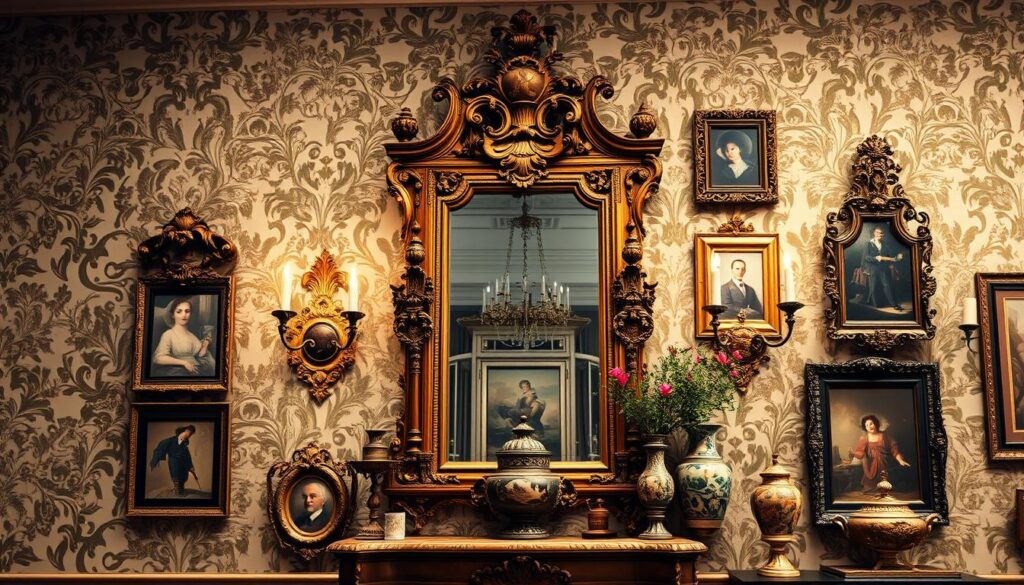
Wallpaper Trends of the Edwardian Era
Wallpaper was big in the Edwardian era for adding color and pattern. Arts and Crafts and Art Nouveau designs were common. They featured flowers, leaves, and shapes.
These designs made rooms feel warm and inviting.
Some famous Edwardian wallpaper designs include:
- Realistic flower patterns
- Geometric shapes like chevrons and hexagons
- Leaf and vine motifs
Wainscoting and Molding Styles
Wainscoting and molding added depth to Edwardian walls. Wainscoting was often oak and on lower walls. Molding framed doors, windows, and ceilings.
These elements brought elegance and sophistication.
Common styles included:
- Paneling with raised or recessed designs
- Ornate molding with detailed carvings
- Classical motifs like egg-and-dart and dentil molding
Using Paint to Enhance Period Features
Paint was also key in Edwardian homes. The right color and finish could highlight period features. Historic paint colors often mimicked nature, with greens, blues, and earth tones.
To use paint effectively, consider these tips:
- Choose colors from the Edwardian era
- Use high-quality paint with the right finish, like eggshell or satin
- Try faux finishes like glazing or ragging for depth
Creating a Cozy Edwardian Living Room
To make a cozy Edwardian living room, mix traditional charm with comfy furniture. We need to think about layout, accessories, and look.
Layout Ideas for Maximum Comfort
A good layout is key for a cozy Edwardian living room. Start with comfy seating, like plush sofas and armchairs in warm fabrics. Arrange furniture to help people talk and feel close.
Adding vintage or vintage-inspired pieces, like a standout armchair or a wooden coffee table, helps. These items make the room look good and feel cozy.
| Layout Element | Description | Benefit |
|---|---|---|
| Comfortable Seating | Plush sofas and armchairs in warm fabrics | Encourages relaxation and conversation |
| Vintage Pieces | Statement armchairs or wooden coffee tables | Adds character and warmth to the room |
| Cozy Textiles | Throws, pillows, and rugs in rich textures | Enhances the sense of comfort and warmth |
Incorporating Period-Appropriate Accessories
To really get the Edwardian living room feel, add the right accessories. Think about vintage decorative items like antique vases, fancy mirrors, and ornate frames.
Choosing accessories means finding a mix of style and use. For example, a wooden side table looks great and holds lamps or other items.
Achieving Balance Between Style and Function
It’s important to balance style and function in an Edwardian living room. Pick furniture and accessories that fit the era but also work for today.
For example, a stylish ottoman is comfy and holds things like throws or pillows. Mixing looks and use makes a room that’s both pretty and practical.
Dining Rooms Inspired by Edwardian Design
To capture the essence of an Edwardian dining room, one must consider the interplay of traditional elements and timeless elegance. The Edwardian era, spanning from 1901 to 1910, was marked by a sense of luxury and refinement in home decor, notably in dining spaces.
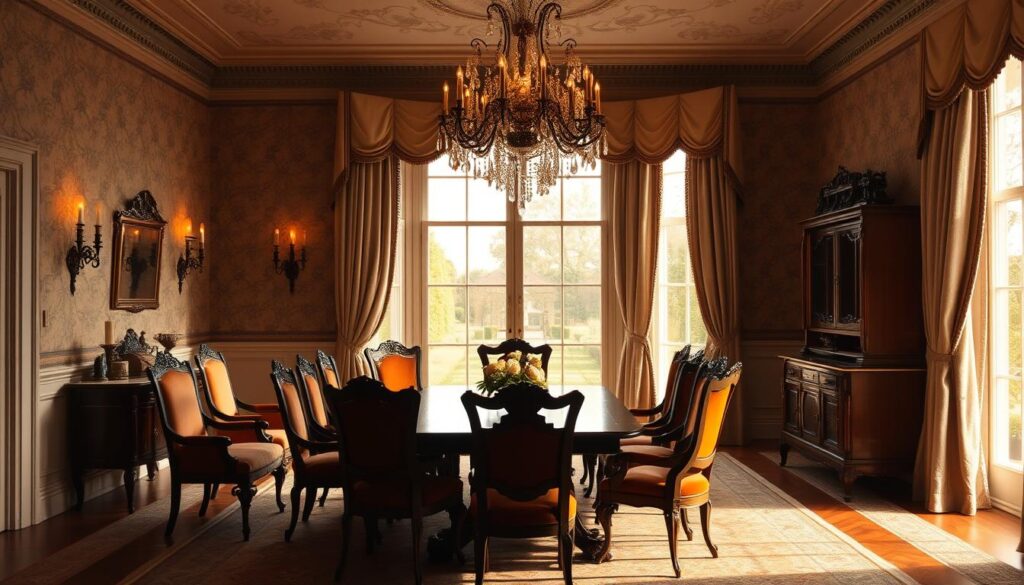
The Importance of a Central Dining Table
The central dining table is the focal point of any Edwardian-style dining room. Typically made from high-quality woods like mahogany or oak, these tables were designed to impress. We recommend looking for tables with intricate carvings or extensions to accommodate larger gatherings.
- Opt for a table with a rich, polished finish.
- Consider the size of your dining area to ensure the table fits comfortably.
- Look for chairs that match the table’s style and material.
Light Fixtures That Complement Edwardian Decor
Lighting in an Edwardian dining room is not just functional; it’s a statement piece. Chandeliers and pendant lights were popular choices, often featuring intricate designs and crystal or glass elements. When selecting a light fixture, consider the scale of your dining room and the style of your table and chairs.
“A well-chosen chandelier can elevate the ambiance of a dining room, adding a touch of sophistication and glamour.”
Displaying Fine China and Collectibles
Edwardian dining rooms often showcased fine china, crystal, and other collectibles. Displaying these items not only adds to the room’s elegance but also pays homage to the era’s love for fine dining and entertaining. Use glass-front cabinets or display shelves to showcase your finest pieces.
- Choose display pieces that reflect the Edwardian era’s style.
- Group similar items together for a cohesive look.
- Consider the lighting around your display to highlight the items effectively.
By focusing on these key elements, you can create a dining room that embodies the classic charm and sophistication of the Edwardian era, perfect for formal dinners and special occasions.
Bedrooms with Edwardian Elegance
An Edwardian-style bedroom is peaceful thanks to its traditional touches. To make such a room, think about the era’s bedroom design. It aimed for calm and comfort.
Essential Edwardian Bedroom Furniture
Edwardian bedrooms had simple yet elegant furniture. Four-poster beds and dresser sets were common, often in mahogany or oak. These items were both useful and beautiful.
When picking furniture, choose pieces with clean lines and little decoration. Focus on comfort and simplicity, just like the era’s design.
Textiles and Fabrics for Authenticity
Textiles were key in Edwardian bedroom design, setting the mood. Linen and cotton were favorites for bedding and curtains, with subtle patterns or embroidery.
To make your bedroom feel truly Edwardian, use traditional fabrics. Think about velvet or damask for upholstery or accents. They add luxury and depth.
Creating a Relaxing Ambiance
Creating a calm Edwardian-style bedroom is more than just furniture and fabrics. It’s about the whole feel. Soft lighting, comfy bedding, and soothing colors all help.
For a calming space, pick your colors wisely. Edwardian bedrooms often had soft tones like pale blues, soft greens, and neutral beiges. These colors help you relax and feel at peace.
Updating Edwardian Interiors for Modern Living
Updating Edwardian homes is a fine art. It’s about keeping their historic charm while adding modern comforts. We need to mix old and new in a way that feels right.
Blending the Old with the New
We can make Edwardian homes modern without losing their charm. Adding smart home tech or energy-saving appliances is a good start. These changes make the homes work better for today’s needs.
Sustainable Practices
Renovating Edwardian homes should be green. Using eco-friendly materials and fixing up what’s already there helps the planet. It also keeps the home’s historic beauty alive.
Preserving Character
Keeping the essence of Edwardian homes is key. We should keep original details like moldings and hardwood floors. Adding touches that fit the era makes the homes feel both old and new.

